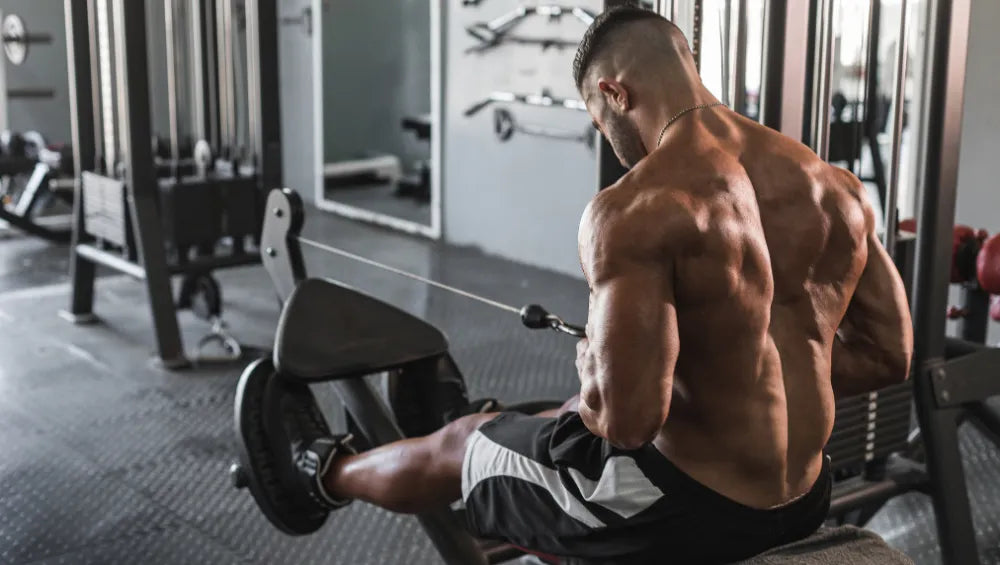Back strength training is an essential part of any strength training program. Yet, many people underestimate its importance, focusing more on visible muscles like the biceps, pecs, or abs. However, a strong back is crucial not only for aesthetics, but also for overall health and injury prevention. In this article, we'll explore the best back exercises , understand the targeted muscles , and help you structure an effective back training program.
You'll also discover scientific studies supporting the importance of back training, how it can improve your posture and athletic performance.
Why is back training important?
The benefits of a strong and muscular back
Having a strong back isn't just about looks. A strong back is essential for:
- Prevent injuries: A strong back protects the spine and reduces the risk of injuries related to poor posture or repetitive movements.
- Improve posture: A strong back supports posture and helps correct body imbalances.
- Optimize athletic performance: A strong back is essential for better performance in disciplines like weightlifting, running, or even yoga.
- Reduce lower back pain: Several studies show that back strength training can effectively reduce lower back pain. (1)
A well-muscled back is therefore essential for maintaining good general physical health and improving your sporting abilities.
Anatomy of the back: Which muscles are targeted?
The back is a complex structure made up of different muscle groups, each playing a crucial role in posture , movement , and spinal protection . There are two main categories of muscles in the back: extrinsic (or superficial) muscles and intrinsic (or deep) muscles . These muscle groups work together to enable movements such as flexion, extension, rotation, and spinal stabilization. Here's a closer look at the muscles to target for effective back strength training, with a focus on their specific roles.
Extrinsic (or superficial) muscles
These muscles are visible and large, and are responsible for movements of the trunk and arms:
- Latissimus dorsi: The main muscles of the back, responsible for arm extension, adduction, and rotation. They also stabilize the shoulder blades during exercises such as rows and pull-ups.
- Trapezius: Located from the neck to the middle of the back, it stabilizes the shoulder blades and manages shoulder movements (elevation and retraction).
- Rhomboids: Located between the shoulder blades, they help bring the scapulae closer to the spine, thus strengthening posture.
Intrinsic (or deep) muscles
Deep muscles stabilize the spine and provide protection to the vertebrae during movement:
- Erector spinae: Extending along the entire length of the spine, they are responsible for extending and stabilizing the trunk, especially in exercises like the deadlift.
- Multifidus: Small muscle located on the spine, essential for stability and injury prevention, particularly in the lumbar region.
- Interspinatus and intertransverse: These deep muscles stabilize the vertebrae and control small movements of the spine.
Muscles of the lumbar region
The lower back muscles are essential for maintaining stability and preventing lower back pain:
- Lumbar muscles (erector spinae): These facilitate flexion and extension of the lower back and are key to maintaining the natural curvature of the lumbar spine.
- Square of the Lumborum: Located on the sides of the lumbar spine, it stabilizes the spine and controls lateral movements and twists of the trunk.
- Deep abdominal muscles: Although not directly part of the back, they support the lumbar region, helping to maintain correct posture and protect the spine.
The best exercises for strengthening your back
For a strong and balanced back, it's essential to target all muscle groups with a variety of back exercises . Whether using dumbbells, barbells, pulleys, machines, or resistance bands, each piece of equipment offers unique benefits.
Here are the most effective exercises to strengthen your back:
| Type of exercise | Exercise | Description |
| Dumbbell Exercises | One-arm dumbbell row | Targets the lats, traps, and rhomboids. Lean forward, keeping your back straight, and pull the dumbbell toward your waist in a controlled manner. |
| Barbell Exercises | Bent-over row | Strengthens your lats, rhomboids, and trapezius muscles. Bend your knees slightly, lean forward, and pull the bar toward your stomach while maintaining good posture. |
| Pull-ups on the fixed bar | Ideal for working the lats and back width. Vary the grips (wide, neutral, or pronation) to target different parts of the back. | |
| Machine exercises | Horizontal machine printing | Isolates back muscles, including the rhomboids and lats. Allows for safe movement control. |
| Vertical machine pull | Targets the lats using a wide or narrow grip. This exercise is excellent for simulating pull-ups while providing optimal trajectory control. | |
| Pulley Exercises | High pulley pull with rope | Targets the lats while activating the biceps and core muscles. Control the movement to maximize muscle activation. |
| Pulley pullover | Stretches and develops your back muscles. Pull the bar or rope toward your waist while maintaining good posture. | |
| Exercises with elastic bands | Rowing with elastic bands | Engages the entire back. Progressive resistance of the elastic bands to adjust the intensity and reduce the risk of injury. |
| Pull-ups with elastic bands | Ideal for beginners, reducing the load at the beginning of the movement while allowing progression towards full pull-ups. | |
| Bodyweight Exercises | Pull-ups | Excellent exercise for strengthening the back muscles, especially the width of the back. Vary the grips to target different parts of the back. |
| Pumps | Although primarily targeting the pectorals, push-ups also activate the back muscles, particularly the stabilizer muscles and trapezius muscles. They improve posture and core strength. |
By alternating these exercises, you work all of the back muscles for harmonious and optimal development.
How to structure an effective back training program?
The frequency and duration of the sessions
To achieve visible results, it is recommended to work your back 1 to 2 times a week. If you are a beginner, start with sessions of 45 minutes to 1 hour.
Back and Biceps Muscle Building Program
| Exercise | Series | Rehearsals | Rest | Muscle target |
| Session 1: Strength and Volume | |
|
||
| One-arm dumbbell row | 4 | 8-12 | 60-90 sec | Back muscles, rhomboids, trapezius |
| Wide grip pull-ups | 4 | 6-10 | 90 sec | Back, upper back |
| Bent-over row | 4 | 8-10 | 90 sec | Back muscles, rhomboids, trapezius |
| Straight bar curl | 3 | 10-12 | 60 sec | Biceps |
| High pulley rope pull | 3 | 12-15 | 60 sec | Back, biceps |
| Session 2: Hypertrophy and Endurance | ||||
| Low Pulley Rowing | 4 | 10-12 | 60-90 sec | Rhomboids, dorsals |
| Pulley pullover | 3 | 10-12 | 60 sec | Dorsals |
| Pull-ups (neutral grip) | 4 | 6-8 | 90 sec | Back, biceps |
| Incline Dumbbell Curl | 3 | 10-12 | 60 sec | Biceps |
| One-arm dumbbell row | 4 | 10-12 | 60-90 sec | Dorsals, rhomboids |
| Session 3: Stability and Strengthening | ||||
| Vertical machine pull | 4 | 8-10 | 60-90 sec | Dorsals, upper back |
| Rowing T-bar (or machine) | 4 | 8-10 | 90 sec | Rhomboids, dorsals |
| Deadlift | 3 | 6-8 | 90 sec | Back, glutes, legs |
| Dumbbell Curl | 3 | 12-15 | 60 sec | Biceps |
| Pumps | 3 | 15-20 | 60 sec | Back, trapezius, chest, arms |
Back workout at home:
- Warm-up: joint mobilization (5-10 minutes) followed by 5 minutes of skipping ropes.
- Classic push-ups: 3 sets of 12-15 reps. Targets the pecs, triceps, shoulders, and also works the back for stability.
- Resistance Band Rows: 3 sets of 12-15 reps. Targets the lats, biceps, and rhomboids.
- Resistance Band Pull-Ups: 3 sets of 12-15 reps. Targets the lats, biceps, and shoulders.
- Plank: 3 sets of 30-60 seconds. Strengthens core stability.
- Superman: 3 sets of 12-15 reps. Targets the lower back, glutes, and improves back stability.
General Recommendations:
- Warm-up: Before each session, be sure to do a thorough warm-up, including shoulder, back, and arm rotations, as well as light exercises like back extensions or assisted pull-ups to prepare your muscles.
- Progression: Increase the weight weekly or monthly, depending on your progress. If you can perform more than 12 repetitions with good form, increase the weight.
- Recovery: Make sure you allow enough time for recovery between upper body strength training sessions. This allows your muscles to repair and grow.
- Form: Form is key to avoiding injury. Don't sacrifice your posture to lift heavier.
- Increase the intensity: Introduce drop sets at the end of each set or super sets to work multiple muscle groups in a row (for example, combining a back exercise with a biceps exercise).
Effective nutrition to maximize your back development
To build back muscle mass, a proper diet is essential in addition to training. Here are the key points to remember:
-
Protein: Consume 1.6–2.2 g of protein per kg of body weight to support muscle repair and growth.
- Sources: Whey , lean meats, fish, eggs, legumes.
- Carbohydrates: Focus on complex carbohydrates (brown rice, vegetables, quinoa) to provide energy to your muscles during training and promote recovery.
- Healthy Fats: Consume unsaturated fats and omega-3s to support muscle hormone production and vitamin absorption. Sources: avocados, oils, fatty fish.
- Micronutrients: Ensure a good intake of vitamins D, C, magnesium, calcium and zinc, which are important for recovery and injury prevention.
- Hydration: Drink 2 to 3 liters of water per day to maintain optimal performance and avoid cramps.
- Meal Timing: Consume carbohydrates and protein before and after training to maximize energy and muscle recovery.
Sleep: An essential pillar for back muscle recovery
Sleep is essential for muscle recovery, including building muscle mass. It promotes muscle fiber repair and the production of growth hormones, which are crucial for muscle growth. Here are some tips to improve the quality of your sleep and optimize muscle recovery:
- Aim for 7-9 hours of sleep per night: Adequate sleep allows your body to repair and rebuild muscles used during training.
- Have a regular sleep routine: Going to bed and waking up at the same time every day helps regulate your circadian rhythm and improve sleep quality.
- Limit caffeine intake in the evening: Caffeine can disrupt your sleep by stimulating the nervous system. Try to limit it to a few hours before bedtime.
- Avoid screens before bed: The blue light from screens (phone, computer, television) can inhibit the production of melatonin , the sleep hormone. It is best to limit their use 30 to 60 minutes before bed.
Conclusion :
A strong, well-muscled back is essential not only for a better physical appearance, but also for overall health and injury prevention. By incorporating targeted and effective exercises like barbell rows, pull-ups, and cable pull-downs, you can not only sculpt your back, but also improve your posture, athletic performance, and reduce chronic lower back pain.
Remember that consistency and progression are the keys to lasting results. It's important to take a thoughtful approach, respecting proper form for each exercise, gradually increasing weights, and allowing your body to rest and recover. By following a tailored, well-structured program, you'll be able to develop a strong, functional back, ready to support your physical efforts in all your activities.
Sources:
- Gordon, R., Bloxham, S. (2016). A Systematic Review of the Effects of Exercise and Physical Activity on Non-Specific Chronic Low Back Pain. Healthcare, 4(2), 22. DOI: https://www.mdpi.com/2227-9032/4/2/22
- Bloxham, S.R., Layden, J., Jane, B., Peers, C., Scragg, S. (2020). The longitudinal effects of a physical activity program on the physical fitness and disability of back pain patients : Service evaluation. BMR Journal, DOI: https://journals.sagepub.com/doi/full/10.3233/BMR-170856
- Hayden, J., Ellis, J., Ogilvie, R., Stewart, S., Bagg, MK, Stanojevic, S., Yamato, T., Saragiotto, B. (2021). Some types of exercise are more effective than others in people with chronic low back pain : a network meta-analysis. Journal of Physiotherapy, DOI: https://www.sciencedirect.com/science/article/pii/S1836955321001028?via%3Dihub














